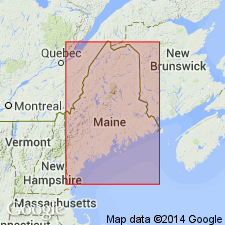- Usage in publication:
-
- Dry Way Volcanics
- Modifications:
-
- Overview
- AAPG geologic province:
-
- New England province
GNU Staff, 1993, GNU Staff remark by E.D. Koozmin. Dry Way Volcanics.: U.S. Geological Survey Digital Data Series, DDS-6, 1 CD-ROM., release 3
Summary:
Dwight Bradley (USGS, oral commun., 6/30/93) says that the unit spelled called Dry Wall Volcanics on ME State Geologic Map (Osberg and others, 1985) is misspelled and is actually Dry Way Volcanics.
Source: GNU records (USGS DDS-6; Reston GNULEX).

- Usage in publication:
-
- Dry Way Volcanics
- Modifications:
-
- Overview
- AAPG geologic province:
-
- New England province
Summary:
Because a formal naming paper has not been published [and Bradley is a USGS co-author], used as Dry Way Volcanics of Griscom (1976) for this report. Consists of basalt in pillows and massive flows. Griscom (1976) estimated stratigraphic thickness as greater than 1.5 km. Basal clastic unit of Ripogenus Formation unconformably overlies Dry Way. Age of Dry Way is Ordovician (Ashgillian).
Source: GNU records (USGS DDS-6; Reston GNULEX).
For more information, please contact Nancy Stamm, Geologic Names Committee Secretary.
Asterisk (*) indicates published by U.S. Geological Survey authors.
"No current usage" (†) implies that a name has been abandoned or has fallen into disuse. Former usage and, if known, replacement name given in parentheses ( ).
Slash (/) indicates name conflicts with nomenclatural guidelines (CSN, 1933; ACSN, 1961, 1970; NACSN, 1983, 2005, 2021). May be explained within brackets ([ ]).

